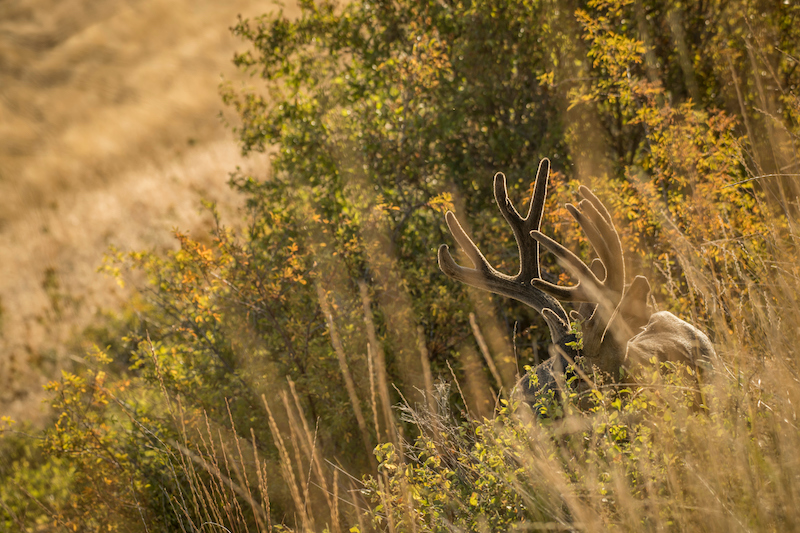A deer is finally in bow range. It’s calm and has no idea you’re near. As you confidently start drawing your bow, the deer bolts and flees. You feel defeated. What happened?
The deer probably saw you move, identified the motion as a threat, and ran for its life. Deer don’t second-guess their survival instincts.
To reach full draw undetected, you can’t make your move at any random moment. You must wait for strategic opportunities that favor you. Let’s review some possibilities.
… the deer is relaxed.

Catch the deer when they are eating. Their guard will be down. Photo Credit: John Hafner
Many predators target white-tailed deer, so they constantly check their surroundings for danger. When calm, they eat, flick their tails, wander around, and lick, scratch and groom themselves. When threatened, they stomp a hoof, bob their head, and sniff the air, trying to confirm their suspicions. To keep deer calm, you must decode their body language. It can mean the difference between getting busted and getting a shot.
Watch the deer’s reactions to determine if it’s content or on high alert. Does it seem nervous or on edge? Is it startled by every breeze, falling acorn, or nearby deer? Or, does it walk with a relaxed swagger? Deer on high alert quickly react to unusual sounds or moves, which makes drawing a bow risky. Don’t move if the deer is wary and alert.
… the deer looks away or moves behind a tree.

Take your shot when the deer is not looking your direction or is hidden behind a tree. Photo Credit: John Hafner
Vision is a superpower in deer because their large eyes are on the side of their head, providing a 300-degree field of view. Their only blind spot is the 60-degree void behind them. If you can see a deer’s eye, it can likely see you. Don’t draw your bow until the deer looks away or puts its head behind a tree or thick brush.
Don’t be fooled into thinking deer can’t see you while browsing. Marty Banks, a professor of optometry and vision science at the University of California-Berkeley, found that deer can see extremely well when their head is down. The whitetail’s eyes, which have horizontally elongated pupils, rotate independently to align with the horizon. To defeat that clear field of view, you must move when their vision is obstructed or the back of their head faces you.
… the deer is within bow range.

Wait until the deer moves into your personal shot range. Photo Credit: ATA
Deer are unpredictable, which makes them fun and challenging to hunt. Even veteran bowhunters get excited, misread the deer’s intentions, and draw their bows too soon. That can be costly.
If a bowhunter’s effective range is 30 yards, and they draw when the deer is advancing at 35 yards, they’re stuck if it stops one step later. That deer might wait several minutes before it resumes walking into range. Most bowhunters at full draw will have tired by then. They’ll have to let down, or risk shaking, which can cause bad or missed shots. If they let down, they risk being seen when drawing a second time.
Know your effective shooting range, and use a rangefinder to identify rocks, trees or bushes that establish distance boundaries. Don’t draw until your quarry is within your lethal range. Although it’s difficult to wait, it boosts your odds of success once you reach full draw undetected. You can shoot the instant you settle your pin over the animal’s vital.

Don’t draw too quickly and spook the deer. Photo credit: ATA
The slower you move, the less likely a deer will notice. After all, predators usually sneak quietly into range of their prey, and then strike with deadly force. Bowhunters are no different. We wait silently in ambush, or we crawl or stalk slowly into range, not drawing our bow until our prey is vulnerable.
Slow draws require an optimal draw weight. A draw weight that’s too heavy often causes bowhunters to lean forward or backward, or raise their bow skyward while drawing. Excessive movements alert whitetails and send them fleeing. Adjust your bow’s weight so you can draw it while seated, which is more difficult than drawing it while standing. That test lets you know if your draw weight is manageable.
If you move slowly and draw your bow when the conditions are right, you’re halfway home. Take a deep breath, aim carefully, and release a clean, ethical shot.